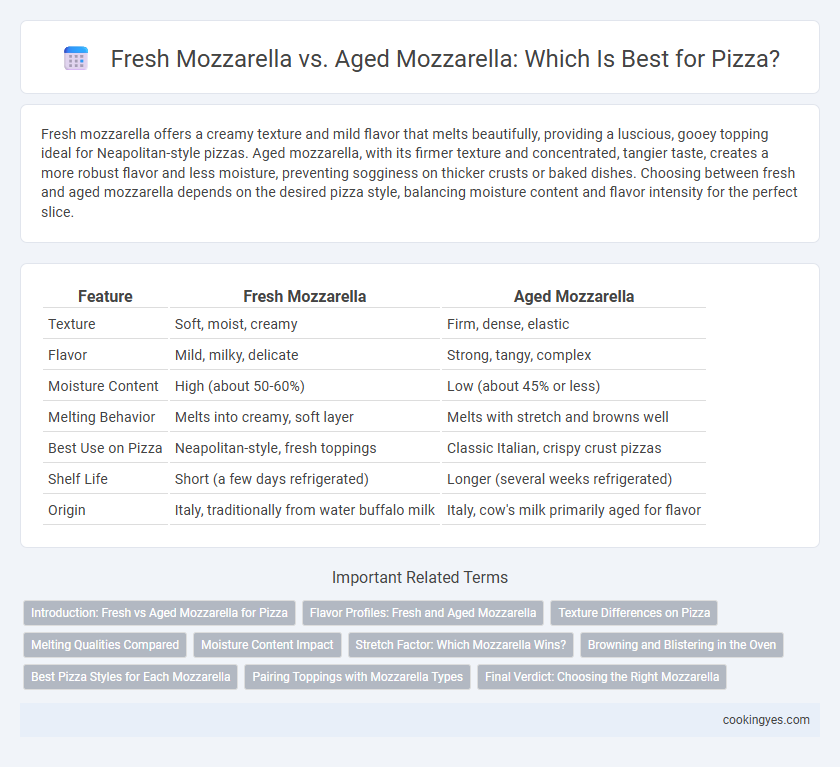Fresh mozzarella offers a creamy texture and mild flavor that melts beautifully, providing a luscious, gooey topping ideal for Neapolitan-style pizzas. Aged mozzarella, with its firmer texture and concentrated, tangier taste, creates a more robust flavor and less moisture, preventing sogginess on thicker crusts or baked dishes. Choosing between fresh and aged mozzarella depends on the desired pizza style, balancing moisture content and flavor intensity for the perfect slice.
Table of Comparison
| Feature | Fresh Mozzarella | Aged Mozzarella |
|---|---|---|
| Texture | Soft, moist, creamy | Firm, dense, elastic |
| Flavor | Mild, milky, delicate | Strong, tangy, complex |
| Moisture Content | High (about 50-60%) | Low (about 45% or less) |
| Melting Behavior | Melts into creamy, soft layer | Melts with stretch and browns well |
| Best Use on Pizza | Neapolitan-style, fresh toppings | Classic Italian, crispy crust pizzas |
| Shelf Life | Short (a few days refrigerated) | Longer (several weeks refrigerated) |
| Origin | Italy, traditionally from water buffalo milk | Italy, cow's milk primarily aged for flavor |
Introduction: Fresh vs Aged Mozzarella for Pizza
Fresh mozzarella offers a creamy texture and mild flavor that melts smoothly, ideal for classic Neapolitan-style pizzas, while aged mozzarella provides a firmer texture and more robust, tangy taste that enhances the depth of flavor on traditional Italian-American pies. The higher moisture content in fresh mozzarella can create a wetter pizza surface, contrasting with the lower moisture and sharper profile of aged mozzarella, which yields a chewier texture and browns more evenly. Choosing between fresh and aged mozzarella depends on the desired pizza style and flavor intensity, balancing meltability with taste complexity.
Flavor Profiles: Fresh and Aged Mozzarella
Fresh mozzarella offers a mild, milky flavor with a soft, creamy texture that melts evenly, making it ideal for pizzas with lighter toppings. Aged mozzarella develops a more intense, tangy taste and firmer texture, providing richer umami notes and enhanced browning when baked. Choosing between fresh and aged mozzarella significantly influences the overall flavor complexity and texture of the pizza.
Texture Differences on Pizza
Fresh mozzarella offers a creamy, soft texture that melts smoothly on pizza, creating a moist and tender bite. Aged mozzarella, with lower moisture content, provides a firmer texture and a slightly chewy consistency that browns well and gives a more robust, caramelized crust. The choice between fresh and aged mozzarella significantly impacts the overall mouthfeel and texture experience of the pizza.
Melting Qualities Compared
Fresh mozzarella melts into a creamy, stringy texture that creates a smooth, tender layer on pizza, while aged mozzarella develops a firmer, more elastic consistency with richer, concentrated flavors that brown more evenly. The high moisture content in fresh mozzarella causes more water release during baking, often resulting in a softer crust, whereas aged mozzarella, with lower moisture, offers better melt control and a chewier bite. Pizzerias frequently choose aged mozzarella for its superior melt stability and enhanced flavor complexity under intense oven heat.
Moisture Content Impact
Fresh mozzarella contains higher moisture content, resulting in a creamy texture that melts smoothly but can make pizza soggy if not properly drained. Aged mozzarella has lower moisture, offering a firmer texture and a more concentrated flavor that browns evenly without releasing excess water during baking. Choosing between fresh and aged mozzarella significantly affects pizza crust crispiness and overall texture due to their distinct moisture levels.
Stretch Factor: Which Mozzarella Wins?
Fresh mozzarella delivers a creamy texture with moderate stretch, ideal for achieving a tender melt on pizza. Aged mozzarella offers a firmer consistency and a superior stretch factor, creating the classic stringy pull that enhances the pizza-eating experience. For the ultimate stretchy cheese effect, aged mozzarella is the preferred choice, especially when baked at high temperatures.
Browning and Blistering in the Oven
Fresh mozzarella melts smoothly on pizza but tends to release more moisture, resulting in less browning and minimal blistering, which can create a softer, creamier texture. Aged mozzarella has lower moisture content, allowing it to brown and blister more easily, producing a desirable golden crust and a slightly chewy texture. The Maillard reaction is more pronounced with aged mozzarella, enhancing the flavor and visual appeal of baked pizza.
Best Pizza Styles for Each Mozzarella
Fresh mozzarella offers a creamy texture and mild flavor ideal for Neapolitan and Margherita pizzas, where its moisture enhances the dough without overpowering toppings. Aged mozzarella provides a firmer texture and stronger taste, perfect for New York-style and Sicilian pizzas that benefit from its excellent melting and browning properties. Choosing between fresh and aged mozzarella depends on desired pizza characteristics, balancing moisture content with flavor intensity.
Pairing Toppings with Mozzarella Types
Fresh mozzarella's creamy texture and mild flavor pair well with light, fresh toppings such as basil, tomatoes, and prosciutto, enhancing the pizza's delicate balance. Aged mozzarella, with its firmer texture and sharper, saltier taste, complements robust toppings like spicy sausage, caramelized onions, and roasted peppers, providing a more intense flavor profile. Choosing the right mozzarella type based on topping intensity ensures a harmonious blend and optimal taste experience.
Final Verdict: Choosing the Right Mozzarella
Fresh mozzarella offers a creamy texture and mild flavor that melts beautifully, creating a soft, luscious pizza topping ideal for Neapolitan-style pies. Aged mozzarella provides a firmer texture and more concentrated, tangy taste that browns well and offers a robust flavor profile suited for New York-style or thicker crust pizzas. The final verdict depends on desired texture and flavor intensity: choose fresh mozzarella for tender meltability or aged mozzarella for a stronger, more pronounced cheesy bite.
Fresh Mozzarella vs Aged Mozzarella for Pizza Infographic

 cookingyes.com
cookingyes.com